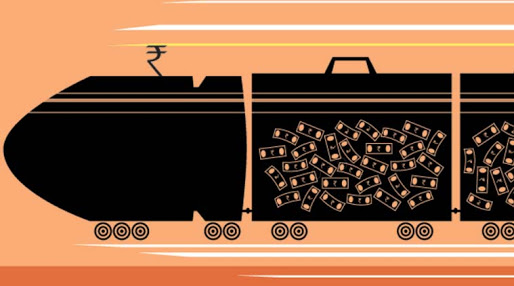The prime minister told captains of industry and finance last week that the economic fundamentals of the country are good and that they must take risks and invest at this point of time. Sage(wise,ज्ञानी) advice, very pertinent(appropriate,उपयुक्त) to the economic crisis we now face.
I invest some of my meagre(small,अल्प) savings in mutual funds. A couple of years ago, seduced by a leading private-sector bank to invest in stocks, I invested a small amount, bought and sold shares as they advised, and ultimately ended up losing money. Fortunately, I did not take too great a hit as the amount invested was small. Now, another bank, which takes care of my mutual funds, advises me from time to time to buy into equity-based mutual funds when the market drops. However, I do not have the guts and prefer at present to keep my money in debt-based liquid funds. With stock prices fluctuating(unstable,घटना बढ़ना) wildly from day to day and the apparent(clear,स्पष्ठ) lack of confidence in the market, I would have to be a brave man indeed to put my money in medium to long-term investments.
I am also on the board of directors of a bank. I hear the same story. My friends in the banking sector say that credit offtake is low and that there are few signs that things will improve in the immediate future. Some of my banker colleagues on the board show no inclination(intrest,रूचि) to take risks and venture into certain areas, even when the borrower has an impeccable(perfect,त्रुटिहीन) record of repayment and interest payment.
I sincerely hope Indian industry follows the PM’s well-meant advice, but somehow it does not seem to gel with ground conditions. Risk appetite seems to be low, whether it is in the corporate or the financial sector. I wonder whether the solution lies in the government, as well as the RBI, taking some risks.
The focus of the government and the RBI seems to be on the fiscal deficit and inflation. There is talk of “reform”, or the lack of it, but this, to my mind, is too nebulous(unfixed,अस्पष्ठ) a concept. Will FDI in multi-brand retail or changes in the land acquisition law bring about the kind of mindset change that will boost the economy? The GST is another matter. I believe its introduction is long-delayed and our lawmakers ought to collectively resolve to put it in place as early as feasible(possible,संभव) for the larger good of the country. Political squabbles(small fight,तूतू मेमे) must not stand in the way. Governance reform also remains critical. The government had taken the right step by asking Bibek Debroy and his committee to examine the manner in which reforms could be brought about in a key sector, the Indian Railways. The report, diluted as it is, does not seem to be seeing the light of day, which, again, does not speak well of the risk appetite of the government.
The bulk of our reforms was carried out in the 1990s. As we go along, more and more changes will take place in our policies, procedures and, hopefully, there will be greater alignment of policy between the Centre and the states.
For a long time now, industry has been crying itself hoarse(harsh,कर्कश) about the need for rate cuts. Now, leading figures in the government and Niti Aayog are also making a pitch for substantial reduction in rates by the RBI. Some small cuts have been made but these are acknowledged to have had no significant impact. The demand now is for greater rate cuts. Yet, there are many who believe that the RBI is already behind the curve and that monetary policy changes at this stage may not have a sufficient impact. Indeed, the question arises as to whether inflation induced by sectoral supply-demand disequilibrium can be addressed through monetary policy, which has an effect across sectors.
Perhaps, today we need something more than sterile(infertile,निष्फल) cries for undefined “reform” and rate cuts. We need a proactive response from the government to the changed economic situation. My mind goes back to 2008-09, when we identified problem areas and evolved specially designed “stimulus packages” to revive flagging sectors and raise supply, demand and confidence all at once.
I am reminded also of the close coordination between the government and the RBI at that time. I recall that the first stimulus package was announced at a press conference at 5 pm one day. An hour later, on the same day, the governor of the RBI announced measures to increase liquidity. The government and the RBI also worked together to persuade(convince,मनाना) public-sector banks to take proactive measures to increase credit offtake. Then, as now, banks were keeping more money in the RBI than the statutory liquidity ratio required. Economists will argue ad nauseam(to a sickening extent,घृणास्पद होने तक) about whether the measures taken then were wise or not. The fact, however, remains that the first green shoots of recovery were seen in India.
Of course, the present emphasis on infrastructure spending is sound and necessary. But we need quick investment. We cannot wait until the railways finds Rs 8 lakh crore for investment and translates it into brick and mortar, even though this is necessary in the long term. Would it not be much easier to let the states borrow more than their fiscal responsibility and budget management limits allow, and spend it on roads, bridges and other construction that would generate jobs, income and greater spending capacity? Would it not be desirable to revive public-private partnerships with such changes as are necessary and create the new institution, “3P”, promised by the finance minister in his budget speech of 2014-15?
There are many questions and I am sure there are many wise brains at work in Delhi. The nation waits with bated(hold,रोककर) breath for dynamic solutions.




No comments:
Post a Comment